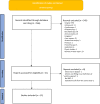State of the art and future challenges of urethra-sparing stereotactic body radiotherapy for prostate cancer: a systematic review of literature
- PMID: 37668718
- PMCID: PMC10632210
- DOI: 10.1007/s00345-023-04579-6
State of the art and future challenges of urethra-sparing stereotactic body radiotherapy for prostate cancer: a systematic review of literature
Abstract
Purpose: Doses delivered to the urethra have been associated with an increased risk to develop long-term urinary toxicity in patients undergoing stereotactic body radiotherapy (SBRT) for prostate cancer (PCa). Aim of the present systematic review is to report on the role of urethra-sparing SBRT (US-SBRT) techniques for prostate cancer, with a focus on outcome and urinary toxicity.
Method: A systematic review of the literature was performed on the PubMed database on May 2023. Based on the urethra-sparing technique, 13 studies were selected for the analysis and classified in the two following categories: "urethra-steering" SBRT (restriction of hotspots to the urethra) and "urethra dose-reduction" SBRT (dose reduction to urethra below the prescribed dose).
Results: By limiting the urethra Dmax to 90GyEQD2 (α/β = 3 Gy) with urethra-steering SBRT techniques, late genitourinary (GU) grade 2 toxicity remains mild, ranging between 12.1% and 14%. With dose-reduction strategies decreasing the urethral dose below 70 GyEQD2, the risk of late GU toxicity was further reduced (< 8% at 5 years), while maintaining biochemical relapse-free survival rates up to 93% at 5 years.
Conclusion: US-SBRT techniques limiting maximum doses to urethra below a 90GyEQD2 (α/β = 3 Gy) threshold result in a low rate of acute and late grade ≥ 2 GU toxicity. A better understanding of clinical factors and anatomical substructures involved in the development of GU toxicity, as well as the development and use of adapted dose constraints, is expected to further reduce the long-term GU toxicity of prostate cancer patients treated with SBRT.
Keywords: Hypofractionation; Prostate cancer; Radiotherapy; SBRT; Toxicity; Urethra-sparing.
© 2023. The Author(s).
Conflict of interest statement
No competing interests concerning the submitted work.
References
-
- NCCN Clinical Practice Guidelines in Oncology : Prostate Cancer. V 3.2022.
Publication types
MeSH terms
LinkOut - more resources
Full Text Sources
Medical


